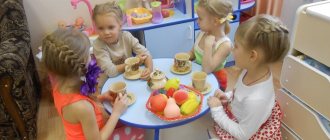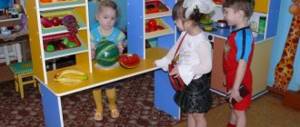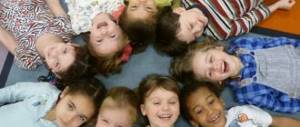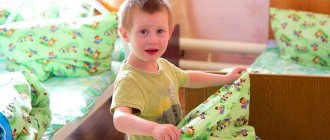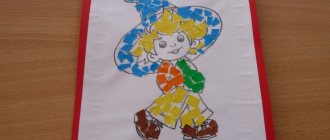Why is work activity needed in kindergarten?
Labor education of preschool children is one of the leading components of the development of a child’s strong-willed, intellectual and creative abilities, and an effective method of forming a culture of social relations. Reasonably organized work develops physical potential, spatial perception of the world, and strengthens the child’s health.
The future now belongs to two types of people: the man of thought and the man of work. In essence, both of them form one whole, for to think means to work.
Victor Hugo
The strategic goal of labor education is the formation of a positive attitude towards work.
This goal can be achieved in two ways:
- To form an understanding of the value and social significance of work.
- Develop and improve basic labor skills, cultivating hard work, organization and responsibility.
The motives for child labor can be different:
- praise and high appreciation of children's efforts from adults;
- self-affirmation among peers;
- the desire to help adults and comrades, to bring real benefit;
- internal interest in mastering new skills, the desire to feel like an adult and independent.
Summary of the organization of collective labor activity in the senior group of kindergarten
Natalia Uvarova Summary of the organization of collective labor activity in the senior group of kindergarten
Topic: Organization of collective work on caring for plants and washing toys.
Types of labor: Labor in nature. Household work.
Goal: Participation of children in organized work of a group of peers; formation of a positive attitude towards work and its results.
Tasks:
Educational:
1. To consolidate and expand children’s knowledge about labor processes: caring for plants, washing toys.
2. Form the habit of a healthy lifestyle.
3. Improve labor skills and abilities in the process of collective work.
4. Develop the ability to plan your activities, interact in a team, and distribute responsibilities among yourself.
Educational:
1. Develop children’s ability to set goals and simply plan the work process.
2. Develop skills of independence, cooperation and initiative.
3. Develop observation and curiosity in children.
Educators:
1. Foster a caring attitude towards plants and a desire to care for them.
2. Cultivate friendly relationships in the process of work, the desire to come to the rescue.
3. Foster hard work, responsibility for the assigned work, and a positive attitude towards one’s own work and the work of one’s peers.
4. Cultivate accuracy and a desire to work in a team.
Preliminary work:
Familiarization with the rules of collaboration; conversations about work: “A small task is better than a lot of idleness”, “Let’s put things in order in the house”; learning proverbs and sayings about work; reading poems (S. Mikhalkov “All by myself”, A. Barto “Grubby Girl”, Y. Akim “Incompetent”, etc.); consolidation of ideas about work through didactic games.
Materials and equipment: sponges, napkins, aprons, watering cans, basins, spray bottle, sticks for loosening the soil, toys, indoor plants (sansevieria, coleus, violet, balsam, ever-flowering begonia, tradescantia, toy - Pinocchio.
Methods and techniques: Creating a game situation, conversation, problematic questions, artistic expression, practical work, relying on children’s knowledge, explanation, demonstration, analysis.
Features of labor education for different age groups
The labor education of children begins at the age of two, when the formation and development of basic self-care skills comes to the fore, and continues until the age of seven. In general, labor education is focused on a variety of tasks that are implemented differently in certain types of activities.
Contents of labor education for children of younger groups
When working with children, it is necessary to develop their basic self-care skills
Children in younger groups are already involved in work activities that are acceptable to them:
- Self-care at this age is focused on the following tasks: developing basic self-care skills (while undressing, dressing, washing hands, eating, keeping your desk in order);
- cultivate neatness, attentiveness and independence while eating (use cutlery, napkins);
- stimulate the internal need for cleanliness and tidiness (wash your hands with soap, wash your face, wipe your face with a towel, use a comb, notice disorder in clothes and try to eliminate it with the help of adults);
- maintain a positive emotional mood in children;
- enrich and activate the dictionary by replenishing it with new names of clothing items.
- neatly stack toys;
- assistance in collecting ripe fruits and seeds;
Video: “Washing our hands” (hygiene lesson in the younger group)
Video: “Masha and the Sweet Kingdom” (lesson on oral hygiene, second junior group)
Video: subject support for work activities in kindergarten
https://youtube.com/watch?v=PrnTtqTPVWc Video can't be loaded: Labor activity in kindergarten, group No. 8 (https://youtube.com/watch?v=PrnTtqTPVWc)
Peculiarities of occupational activities for hearing-impaired and deaf children
Features of the development of hearing-impaired children entering correctional groups of kindergarten:
- poor self-care skills due to excessive care from adults;
- disturbances in speech development, as a result - a low level of development of objective and play activities.
Algorithm for working with hearing impaired children:
- The first stage (2–4 years) is manipulative activity with household objects. For hearing-impaired children, the main channel of perception is visual, therefore the main pedagogical method aimed at developing a stable skill is demonstration - the teacher shows each operation, commenting on his actions. Then the teacher performs joint actions together with the baby, for example, taking the baby’s hands in his own, soaping, rinsing, wiping dry with a towel. This is how the child develops and consolidates an elementary sensorimotor skill. Gradually, the child is given more independence and freedom of action. The teacher controls the process of performing operations and the result, then only the final result.
- The second stage (4–7 years) – adult tools are added to household items, and the use of chart cards and drawn algorithms is added to pedagogical methods. In the process of work, the child learns to understand and carry out work assignments, coordinate and plan his actions (“first we’ll draw the shape of the part, then we’ll cut it out, first we’ll outline it, then we’ll sew it on”), learns the meaning of new words and terms, and develops communication skills.
Work progress:
1 part. Children enter the group. Suddenly the voice of the Fairy of Purity sounds. (Dear guys, I am the fairy of Purity. I travel around the world and will come to you soon). How do we prepare to welcome guests? (children: cleaning up, preparing a treat)
How else?
Guys, what will help us in our work? (music, proverbs, sayings)
Educator
: Guys, do you know proverbs
(yes)
Kira, what proverb do you know?
Kirill, what proverb do you know? And I know the proverb: people honor those who love work
.
How many proverbs do you know! Where should we start preparing? (children from cleaning)
.
Educator
: Let's choose what we will clean
(dust, do laundry, wipe down chairs)
.
Educator
:
1st team - wipes dust in cabinets and arranges toys beautifully
2nd brigade - washing doll clothes
3rd brigade - washes chairs
Educator
: Guys, what do you need for work?
(basins, rags, etc.)
Please prepare your work stations. (children get ready)
Educator
: I propose to distribute responsibilities: who will do what, says.
Guys, tell us who will do what in your team? (Yura pours water into the basin, Arina does the laundry, etc.)
Teacher
: The quality of the work performed by the entire team depends on the work of each individual.
Part 2: Practical work.
Educator
: Well done boys!
Please tell us what your team will do? Let's see if you have everything ready. (
teacher shows illustrations)
. Everything is ready, let's start working
.
During work activities, the teacher gives advice
, helps in organization, reminds the order of work.
Educator
: Are you comfortable?
Why does water flow from a rag? Why are you moving chairs? Who is responsible for arranging books on shelves? Guys, your work is in full swing! Well done! What labors and fruits
!
Without action, strength weakens! A bird is recognized in flight, and a man is recognized in his work
!
Part 3: Summing up the work. Evaluation of the application's implementation.
The teacher is watching
so that after completion of work, children clean up their work places and put all materials and equipment back in place.
Then he invites you to admire the results of your labor
. The team that finishes first approaches other teams and offers their help.
Educator
: You guys are great, you got the job done.
Let's see what kind of chairs we have? (clean, beautiful)
Let's see what our other teams are doing?
Educator
: The foremen take turns telling what they did and giving their own assessment of the activities of their team.
Educator
: What did you do?
(addressing each team)
Did you guys enjoy
working
?
What did you like best? What would you like to do in the future? Let's see how things are going in our group? (inspection of the group)
.
Educator
. Each of you did your own little thing, but together you did a big thing. This is how clean and beautiful the room is now. Congratulations guys, the job is finished.
Goal: developing a positive attitude towards work in children of senior preschool age. Teach children to help adults, maintain order in the group: - wipe off dust - wash toys Tasks:
· Consolidate and improve skills previously acquired in work.
· Contribute to enriching the child’s development of interest in adult activities; desire to provide assistance by creating a positive atmosphere at work. Improve work skills while working
· Learn to maintain order in closets with toys and equipment; work together, agree on the distribution of responsibilities,
· notice the disorder, offer to eliminate it, and, if necessary, provide each other with help.
· Develop the ability to communicate with adults and develop sociability.
Equipment:
oilcloths, basins, rags, toys, a bag, basins, tables, bench, soap dishes, sponges, napkins, buckets of water; brushes, aprons.
PROGRESS OF THE CLASS
Educator: Guys, today we will continue to talk with you about work and hard work. Tell me, please, do you often sit at home doing nothing or do you always find something to do? (Children's answers.)
Let the toys be friends with us We won’t offend them We’ll play, and then we’ll put everything back in its place We’ll help ourselves We’ll put them in their places
And they really don’t like it when they break them!
our group is always clean and beautiful.
What do I need to do? (Children's answers).
I will read an excerpt from a poem by K.I. Chukovsky "Fedorino's grief". (Is reading).
Children, why did all the things run away, galloped away from Fedora? (Answers).
What would happen if you scattered all the toys and broke them? (Answers). That's right, the toys would run away and things would get worse without them. What if you threw your things everywhere? (Answers).
That's right, they would have to be looked for. What if the dishes were washed and put away after eating? (Answers).
That's right, then everything would be fine. And Marina Nikolaevna would say: “Well done, my assistants!” Tell me, would it be good or bad if you treated things with care, took care of them, took care of them? (Answers).
Now, if Fedora had cleaned her apartment, washed the dishes, and looked after the flowers, then no one would have run away from her.
What fairy tales about labor do you remember?
"Cinderella", "Dragonfly and Ant".
Well done! At home you are always busy doing something useful, helping your mom, dad, grandparents, and your younger brothers and sisters. How do people talk about a person who works hard? (Children's answers.)
What can we call a dragonfly? Why?
What do we say about the ant? Why?
Today we will show how big and hardworking we are.
But before that. How to do this, let's distribute responsibilities among ourselves. One group (team) of children should help Marina Nikolaevna in the group, wipe the dust on window sills, shelves, the second team should wash and wipe toys and building materials. The third team works in the doll corners, the fourth team wipes dust from bookshelves, stacks books, albums, paintings, waters flowers, and sprays. Children, but do not forget to agree on who will do what.
That's right, we talked about work, diligence, and the fact that everyone should work. That work is good, but laziness is bad, and from idleness there is always sadness and punishment. You are all very hardworking guys, you worked hard in the group, we did a good deed. And if you help at home like this, then your parents will be very glad that their children have grown up and become great helpers.
Educator
Did you have any difficulties while working? - asks the teacher. (Child’s answer).
Children, did you enjoy working together? (Answers).
How clean it has become! Well done, children! You all worked together and did a good job, and I see that you have already grown up. Everyone did their own little thing, but everyone together did a great common cause.
Summary of work activities in the senior group. lesson plan (senior group) on the topic
Summary of work activities in the senior group.
Author-developer: Oksana Yuryevna Sklyarova, teacher of the BDOU of the city of Omsk “Kindergarten for care and health improvement No. 30”.
Topic: “General cleaning of the group”
Types of activities: labor, communication.
Forms of implementation: collective work.
Goal: to form the habit of maintaining cleanliness and order in the group.
Tasks:
1) Improve the ability to wash doll dishes, wipe dust on furniture, carefully arrange toys and aids in closets.
2) Strengthen children’s ability to plan activities and agree on the distribution of responsibilities. Understand that the work of the subgroup is part of the overall cause.
3) Develop accuracy and diligence.
4) Develop the ability to bring the job started to completion.
Equipment: 4 pictures-tips, algorithm of stages of labor activity, cards-schemes, aprons, oilcloths, buckets, basins, soap, rags, napkins.
Stage 1. Motivation of children to activity.
Educator: “Guys, what holiday will we celebrate at the end of November? (Mothers Day).
How do we prepare for it? (We drew portraits of mothers, made postcards, learned poems, and prepared a concert). On this day, your mothers will come to visit us. Is everything in the group ready for the guests to arrive?”
Stage 2. Children setting goals for upcoming activities.
Educator: “How to prepare a group for the arrival of guests?
What should be done? (Clean up order. Arrange toys, etc.)
And, do you agree to make our group clean, neat, cozy?”
Stage 3. Working together with children to find means of activity.
Educator: “You said that we need to restore order. What exactly needs to be done?”
(If the children do not name something, then invite them to look at the clue pictures. For example, chairs are drawn, and next to them is a basin, soap and a rag).
Educator: “What do we need to do today?” (Wash the chairs).
Three more pictures are considered in the same way: a cabinet with doll dishes is drawn, next to it is a basin, soap and a rag - wash the doll dishes. Also, clean up the traffic rules corner and wipe the dust in the toy cabinets.
Educator: “How are we going to work today? What will be more convenient, faster? (Children's answers). I propose to divide into teams. We will select the foremen by drawing lots. (They choose). Now I invite the foremen to choose a picture where your team will work. (The foremen go out and choose one by one.) Foreman, I ask you to choose assistants for your teams. (Call the names of the children)
Educator: “We have teams, we have foremen. Each team knows where it will work. Can we get down to business? Are we all ready? (No).
What else needs to be done to start working? (Wear aprons). What else?
(If children find it difficult, then offer them help).
Educator: “Look, there are pictures of us, they will help us. What do they mean?
(1 - put on an apron, 2 - prepare the place, 3 - prepare equipment, 4 - distribute the stages of work and complete it, 5 - clean your workplace, 6 - remove the apron, 7 - wash your hands).
Educator: “I invite each team to choose everything they need and go to their workplaces.” (The teams take turns going out and choosing their equipment for work).
It is recommended to start cleaning in a good mood, and music will help us with this.
While the music is playing, we work; if the music is over, we finish, put things in order.
Stage 4. Independent work of children to test methods of activity.
The children get to work. An audio recording of cheerful music plays. During work, I coordinate the work of the units, help with organization, remind them of the work order (I use cards and diagrams). Shutdown.
Educator: “Guys, the music is over. What should be done?" (Clean up your workplace, take your equipment to its place)
Stage 5. Reflection, summing up, discussion of results.
Educator: “Let's go through the group and look at the results of your work.
Whose brigade restored order here? Did you get everything done? Did you finish the job you started?”
(The results for all teams are summarized similarly).
Educator: “Well, is our group now ready for the guests to pass through? Will your moms like it in our group? What have we done to make our group clean and tidy? (Children's answers). Each of you did a small thing, but together you did a big, common thing.”
Ah, now I ask you to evaluate yourself. If you think that everything worked out for you, you are satisfied with your work - give yourself a pat. If you think that you didn’t succeed, you are unhappy with your work - just shut up and think about what you need to do next time to make everything work out.
